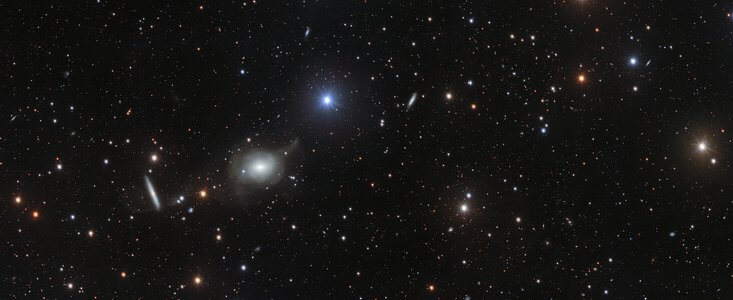Many luminous galaxies fill this rich image taken with ESO's VLT Survey Telescope, an advanced 2.60-metre telescope designed to survey the sky in visible light. The features of the many galaxies scattered across the image allow astronomers to reveal the finest details of the galaxy's structure

Many luminous galaxies fill this rich image taken with ESO's VLT Survey Telescope, an advanced 2.60-metre telescope designed to survey the sky in visible light. The features of the many galaxies scattered across the image allow astronomers to reveal the finest details of the galaxy's structure.
Many luminous galaxies fill this rich image taken with the survey telescope VLT של ESO, an advanced 2.60 meter telescope designed to survey the sky in visible light. The features of the many galaxies scattered across the image allow astronomers to reveal the finest details of the galaxy's structure.
The European Southern Observatory's (ESO) Very Large Telescope (VLT) can observe very faint astronomical objects in great detail, but when astronomers want to understand how the vast array of galaxies formed they must turn to a different type of telescope with a much larger field of view. The VLT Survey Telescope (VST) is such a telescope. It was designed to study vast swaths of the clear Chilean night sky, allowing astronomers detailed astronomical surveys of the Southern Hemisphere.
The powerful surveying properties of VST led an international team of astronomers to conduct the VST Early-Type Galaxy Survey (VEGAS) to examine a collection of elliptical galaxies in the Southern Hemisphere. Using the sensitive OmegaCAM detector at the heart of VST, a team led by Marilena Spabona of INAF – Capodimonte Astronomical Observatory in Naples, Italy captured images of a wide variety of such galaxies in different environments.
One of these galaxies is NGC 5018, the milky white galaxy near the center of this image. It is in the constellation Virgo (Virgo) and at first glance it may look like just a scattered blob. But on closer inspection, one can see a thin stream of stars and gas—a tidal tail—stretching outward from this elliptical galaxy. Subtle galactic features such as tidal tails and stellar streams are hallmarks of intergalactic interaction, and provide vital clues about the structure and dynamics of galaxies.
In addition to the many elliptical (and a few spiral) galaxies in this great 400 megapixel image, the image also features a colorful array of bright foreground stars in our Milky Way Galaxy. These push stars, like HD 114746 clearly visible in blue near the center of the image, are not the intended subjects of this astronomical portrait, but happen to be between Earth and the distant galaxies being studied. Less noticeable, but no less fascinating, are the faint traces left by asteroids in our solar system. Just below NGC 5018, the faint streak left by asteroid 2001 TJ21 (110423) — captured in several subsequent observations — can be seen stretching across the image. Farther to the right, another asteroid—2000 WU69 (98603)—left its mark on this spectacular image.
The astronomers set out to study the subtle properties of galaxies millions of light-years away from Earth, but in the process they also captured images of nearby stars hundreds of light-years away, and even the faint traces of asteroids just light-minutes away in our solar system. Even when exploring the farthest reaches of the universe, the sensitivity of ESO's telescopes and the dark Chilean sky can offer mesmerizing observations much closer to home.
More of the topic in Hayadan:
